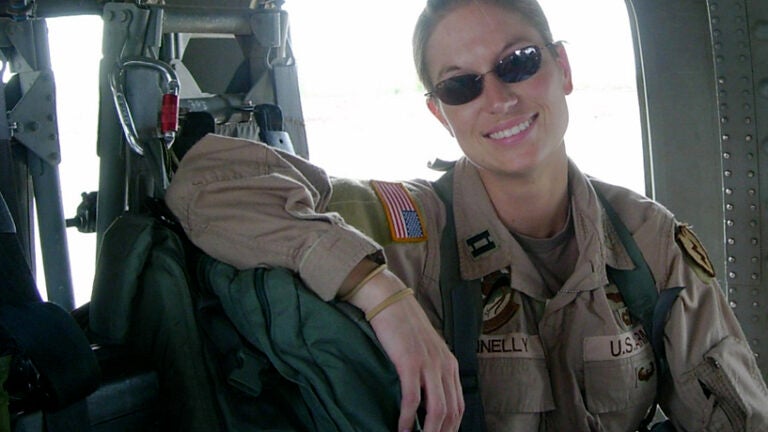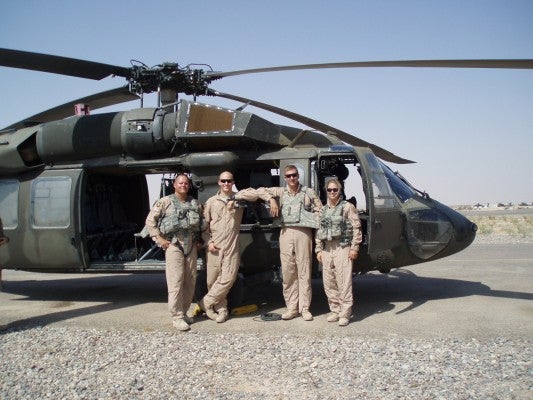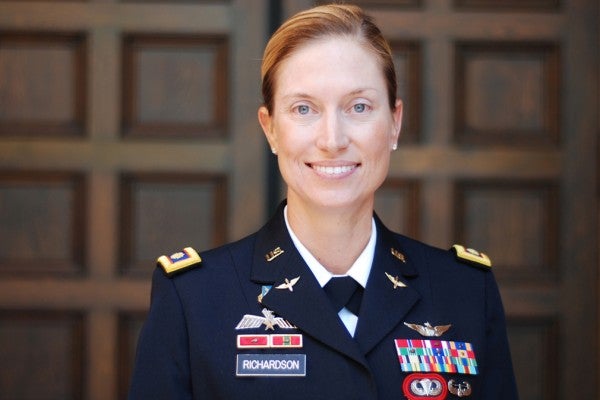
Kristina Richardson inside a UH60 Blackhawk during her tour in Iraq (Photo/courtesy of Kristina Richardson)
An Army aviator with her feet on the ground
Iraq war veteran and PhD student at USC Viterbi has broken barriers and brought hope to many on the battlefield
In Iraq, the metronomic whoop whoop of an approaching Blackhawk helicopter under the cover of darkness could mean one of two things: fear or hope.
For a wounded marine in the battlefield, knowing that Major Kristina Richardson was piloting meant help was on the way.
It’s hard to imagine anything close to hope in an environment like Iraq. Getting a bird’s-eye view flying over the fog of war, there was no escaping the human toll: wounded soldiers, Iraqi funerals happening every day, counterinsurgency spreading like an inkblot on paper.
Richardson has the sort of credentials that impress generals. She earned a master’s in engineering and management from the Massachusetts Institute of Technology, a BA in environmental engineering from West Point, went to flight school in Alabama and deployed to combat in Iraq during The Surge (2006-2007) in support of the 25th Infantry Division.
She is now studying for a PhD in systems engineering at the USC Viterbi School of Engineering.
From combat to research
Richardson was the pilot-in-command for VIP, air assault and air movement tactical operations in Iraq, where she was directly responsible for the training and safety of 50 soldiers and more than $80 million in military equipment.
But what cemented Richardson’s reputation was her transition from the battlefield into groundbreaking research that went beyond identifying the bad guys and their locations.
“It was a completely different turn for my career track,” Richardson said. “Certainly not a traditional aviator’s experience, but it got me out of my comfort zone.”

It’s hard to picture Richardson out of her comfort zone considering her willingness to assume extreme risks with a no-frills attitude. The native of Venice smiles often and exudes a Southern California confidence that instantly makes you wish she was your best friend.
A Veteran’s Day photo posted on her Facebook wall gives a sense of the bond she shared with the soldiers she commanded into battle:
“Easily on the list of best life experiences. Great people,” wrote a young pilot who served his first deployment under Richardson.
“Hands down, most fun I’ve had flying,” replied another.
Upon returning from Iraq, Richardson went on to teach systems engineering at West Point, where she assumed her default posture of listening rather than lecturing to her cadets. But they couldn’t keep this aviator out of the skies. She flew the UH72 Lakota helicopter in support of the West Point Parachute Team.
Last summer she earned her “Dutch Airborne” wings after parachuting out of a UH60 Blackhawk with the Army Special Forces at Fort Bragg.
Breaking barriers
To perform effective counterinsurgency and counterterrorism, analysts like Richardson needed a deep understanding of the tribal, social and political relationships in their theaters — specifically, who were the power brokers and what were their connections?
Then there was researching the culture of U.S. and NATO forces, giving an insider’s perspective to think-tank experts who were advising the top echelons of the Pentagon.
Richardson felt fortunate to have her broad combat experience to pull from but remained troubled by how few women had access to these roles due to the military’s combat exclusion policy. The long-standing rule has barred women from some of the front lines of combat and the advancements in rank, job and pay that come with it.
In 1994, following the Gulf war, the Pentagon declared:
“Service members are eligible to be assigned to all positions for which they are qualified, except that women shall be excluded from assignment to units below the brigade level whose primary mission is to engage in direct combat on the ground.”
Women in combat
Richardson embodied the story of these women as they moved from selection through training to night raids and other combat operations.
We have to remember the exclusion policy dates back to 1948 when the lines of combat were clearly drawn.
Kristina Richardson
“We have to remember the exclusion policy dates back to 1948 when the lines of combat were clearly drawn,” she explained. “We’re no longer fighting that kind of war. In Iraq, in Afghanistan, women find themselves in combat situations at any time regardless of their assignment.”
In 2013, then-Defense Secretary Leon Panetta, after seeing firsthand the impact women like Richardson had on the battlefield, directed an end to the combat exclusion rule. At the time of Panetta’s directive, about 15 percent of the active-duty force were women.
“It was then that I was assigned to research and evaluate what would be the impact of integrating women in Army special operations command,” Richardson said.

“I wanted to make sure that my findings were based on factual analytical studies that clearly indicated whether or not women had the specialty skill set required to fulfill certain missions.”
The service secretaries were given until Jan. 1, 2016 to decide if they would integrate women into those occupations.
“I was happy to have a piece of that,” Richardson said. “To give them the data they need to make a good decision.”
When she’s not parachuting out of helicopters, or conducting high-stakes policy research, or writing her dissertation, Richardson is a new mother, raising her 8-month old son, Zac, whose premature birth she still considers “one of the scariest moments in my life.”
Her husband, Troy Zwirblia, is also an aviator who flies helicopters and airplanes for the Army.
With a PhD from USC in her official record, Richardson looks to return to the skies with a lot of hope: “I can have an even bigger impact in the lives of our servicemen and women and do the things that other people with PhDs are now doing for us.”



